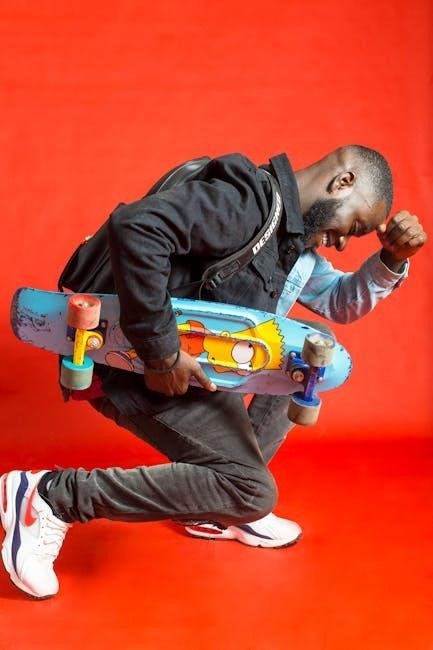Choosing the right skateboard size is crucial for performance, control, and comfort. This guide covers deck width, length, and wheelbase, helping you find the perfect fit based on age, shoe size, and riding style.
Understanding Skateboard Deck Width
Deck width is the most critical factor in determining how a skateboard feels underfoot and what kind of tricks or riding styles it suits best. Skateboard decks typically range from 7.00 to 8.5 inches in width, with narrower boards (7.00–7.50 inches) ideal for younger riders or street skating, where agility and trick performance are prioritized. Medium-width decks (7.50–8.00 inches) are versatile and suitable for teens or adults skating street terrain or doing tricks. Wider decks (8.25–8.5 inches) are better for cruising, transition skating, or taller riders, offering stability and comfort. The width also impacts the board’s responsiveness and balance, making it essential to match it to your skating style and personal preference. A wider deck provides more stability, while a narrower one allows for sharper turns and easier flips. Choosing the right width ensures optimal performance and enhances your overall skating experience.
Importance of Deck Length and Wheelbase
Deck width often takes precedence, but deck length and wheelbase are crucial for performance. Deck length affects comfort and maneuverability—longer for cruising, shorter for tricks. The wheelbase, the distance between trucks, impacts stability and turning. A longer wheelbase stabilizes at higher speeds, ideal for carving, while a shorter one allows tighter turns for street skating. Although deck width is key, length and wheelbase also influence responsiveness. Most boards have standardized lengths and wheelbases that complement their width, ensuring a balanced ride. Understanding these aspects helps riders choose a board that suits their style, optimizing performance and comfort. Together, these dimensions create a skateboard tailored to individual needs, enhancing the skating experience with balanced handling and responsiveness.

Skateboard Size Chart
This chart provides a detailed guide to finding the perfect skateboard size based on deck width, age, shoe size, and height, helping riders choose a board that suits their needs and style.
Deck Width Recommendations by Age Group
Deck width varies by age due to differences in foot size and balance. For children aged 5-10, narrower decks (7.0-7.5 inches) are ideal for better control. Teens (11-17) often prefer medium widths (7.5-8.0 inches), offering stability for tricks and street skating. Adults typically opt for wider decks (8.0-8.5 inches) for comfort and cruising. Proper fit ensures better performance and safety, making age-based recommendations a great starting point for choosing the right skateboard size.
Skateboard Size Based on Shoe Size
Your shoe size can help determine the ideal skateboard size. Generally, smaller shoe sizes (6-8) pair well with narrower decks (7.0-7.5 inches), providing better control. Medium shoe sizes (8-10) suit decks of 7.5-8.0 inches, balancing stability and maneuverability. Larger shoe sizes (11+) often prefer wider decks (8.0-8.5 inches) for comfort and support. This correlation ensures your feet fit comfortably on the board, enhancing performance and reducing fatigue. Matching shoe size to deck width is a practical approach for selecting the right skateboard, though personal preference and skating style should also be considered.
Height and Skateboard Size Correlation
Height plays a significant role in determining the ideal skateboard size. Taller riders typically require larger decks for better stability and comfort, while shorter riders may prefer smaller boards for easier maneuverability. Generally, riders under 4’4″ (132 cm) benefit from narrower decks (7.0-7.5 inches), while those between 4’5″ and 5’5″ (134-165 cm) often find 7.5-8.0 inch decks suitable. Taller riders (over 5’6″ or 168 cm) may prefer wider decks (8.0-8.5 inches) for optimal control. This correlation ensures the board feels proportional to the rider’s body, enhancing balance and performance. However, height is just one factor; personal skating style and shoe size should also be considered. By aligning deck size with height, riders can achieve a more natural and comfortable skating experience. This guide helps you narrow down the options, but remember, individual preferences may vary. Always test a board if possible to ensure the best fit.

How to Choose the Right Skateboard Size
Selecting the right skateboard size involves measuring your height, shoe size, and considering your riding style. Use a size chart to align your dimensions with deck width and length for optimal fit and performance.

Step-by-Step Guide to Measuring for the Perfect Fit
To ensure the perfect fit, start by measuring your height and shoe size. Use a skateboard size chart to match these measurements with deck width and length. Stand barefoot or in skating shoes, with feet shoulder-width apart, to determine your stance width. Place a ruler or measuring tape across the balls of your feet to find your foot length. Compare these measurements to the deck’s width, ensuring it aligns with your shoe size and riding style. For example, if you wear a size 9 shoe, opt for a deck width between 8.0 and 8.25 inches. Additionally, consider your height; taller riders may prefer longer decks for stability. Finally, check the wheelbase, which affects turning radius and balance. By following these steps, you can select a skateboard that feels comfortable and suits your skating needs.
Matching Deck Width to Riding Style
Deck width plays a significant role in determining how a skateboard performs based on your riding style. For street skating and tricks, narrower decks (7.5″–8.0″) are ideal, offering better flip control and agility. Cruisers and those preferring stability should opt for wider decks (8.25″–8.5″), which provide a smoother ride and easier balance. Transition skaters often prefer medium widths (8.0″–8.25″) for a balance of control and stability. Longboarders may choose even wider decks (8.5″ and above) for carving and downhill performance. Consider your primary skating style to match the deck width accordingly. A narrower deck enhances trick performance, while a wider deck improves stability for cruising. Personal preference also plays a role, so test different sizes if possible. Ultimately, aligning deck width with your riding style ensures a more enjoyable and tailored skating experience.

Truck Size and Wheel Diameter Considerations
Truck size and wheel diameter are crucial components that complement deck width and riding style. Trucks are measured in millimeters, with common sizes ranging from 125mm to 149mm, and should align with deck width for optimal stability. Narrower decks (7.25″–7.75″) pair with smaller trucks (129mm–139mm), while wider decks (8.25″–8.5″) require larger trucks (149mm–159mm). Wheel diameter, typically between 50mm–60mm, impacts speed and terrain adaptability. Smaller wheels (50mm–54mm) are ideal for street skating and tricks, offering quick acceleration and maneuverability. Larger wheels (55mm–60mm) suit cruising and rough surfaces, providing stability and smoother rides. Harder wheels (95A–101A) are better for street and tricks, while softer wheels (78A–87A) enhance grip for cruising. Balancing truck size, wheel diameter, and deck width ensures a harmonious setup tailored to your skating style and preferences, enhancing performance and overall skating experience. Proper alignment and compatibility are key to achieving the desired ride quality and control.
Additional Considerations
Personal preference, brand variations, and first-time buyer tips play a role in choosing the right skateboard. Ensure proper fit and alignment of components for optimal performance and comfort.
Personal Preference and Skateboard Fit
Personal preference plays a significant role in determining the ideal skateboard fit. While size charts provide a general guide, individual comfort and skating style can influence deck width and overall board feel. Riders who prioritize stability may opt for wider decks, while those focused on tricks or street skating often prefer narrower widths. Shoe size and height correlations are helpful starting points, but personal comfort should ultimately guide the decision. For example, a taller rider might prefer a slightly longer wheelbase for better balance, while a shorter rider might find a narrower deck more manageable. Additionally, some skaters value lightweight setups for agility, while others prefer sturdier builds for durability. Personalizing the skateboard to match your unique needs ensures a more enjoyable and effective skating experience. Remember, the right fit is about how the board feels under your feet, not just the numbers on a chart.
Brand Variations in Skateboard Sizing
Skateboard sizing can vary significantly between brands, as each company may have its own specifications for deck width, length, and wheelbase. While general size charts provide a useful starting point, it’s important to consider brand-specific differences. Some brands offer wider decks for stability, while others focus on narrower widths for trick-oriented skating. Additionally, the shape and concave of the deck can differ, affecting how the board feels underfoot. For example, certain brands cater to specific skating styles, such as cruiser boards with longer lengths or street skating decks with responsive setups. It’s essential to check the sizing guide for each brand, as their measurements may not align perfectly with universal charts. Reading reviews and trying out boards in person can also help you understand how a particular brand’s sizing works for your needs. By accounting for these variations, you can find a skateboard that fits both your style and preferences. Proper fit is crucial for performance and comfort, so don’t hesitate to explore options until you find the right match. This attention to detail ensures a more enjoyable and tailored skating experience.
Final Tips for First-Time Buyers
When purchasing your first skateboard, prioritize comfort and functionality. Start with a deck width that matches your shoe size and skating style for better control. Consider a medium-width deck (7.5″-8.25″) for versatility. Ensure the trucks and wheels align with the deck size for optimal performance. Test the board if possible, or refer to brand-specific size guides. Personal preference plays a significant role, so don’t hesitate to seek advice from experienced skaters or shop staff. Investing in a complete skateboard rather than individual parts can simplify the process. Remember, proper sizing enhances stability and maneuverability, making learning easier and safer. Don’t be afraid to explore different options until you find the perfect fit. With patience and the right setup, you’ll be ready to hit the streets or park in no time. Happy skating!

Leave a Reply